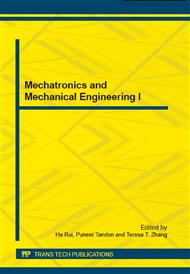p.288
p.293
p.298
p.304
p.313
p.318
p.326
p.331
p.336
Comparative Research of 240-Coil Permanent Magnetic Brushless Motor with or without Potting Compound
Abstract:
In the design and analysis of motors, the issue of heat transfer is an important subject because it is relevant to the motor’s size and life. So, this study used an experimental design with the Taguchi Method to understand performance of epoxy resin on permanent magnetic brushless motors with 240 coils. The objects used for the experiment were a permanent magnet brushless motor with a 240 coiling number and a potting compound. The experiment was conducted to explore effectiveness of potting to reduce temperature. The Taguchi Method was applied to determine the optimal sample combination to obtain maximal experimental effectiveness by minimal test frequency. The results revealed from this study were positive for potting compound to transfer heat.
Info:
Periodical:
Pages:
313-317
Citation:
Online since:
October 2014
Authors:
Price:
Сopyright:
© 2014 Trans Tech Publications Ltd. All Rights Reserved
Share:
Citation:


